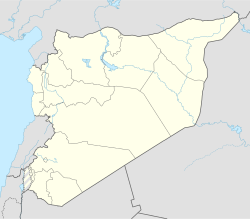Saida, Syria
Saida
صَيْدَا | |
|---|---|
Village | |
| Coordinates: 32°37′42″N 36°13′34″E / 32.62833°N 36.22611°E | |
| Grid position | 265/226 PAL |
| Country | |
| Governorate | Daraa |
| District | Daraa |
| Subdistrict | Daraa |
| Control | |
| Population (2004 census)[1] | |
• Total | 11,215 |
| Time zone | UTC+2 (EET) |
| • Summer (DST) | UTC+3 (EEST) |
Saida, also spelled Sayda (Arabic: صَيْدَا, romanized: Ṣaydā), is a village in southern Syria, administratively part of the Daraa Governorate, located east of Daraa. Nearby localities include al-Naimah to the west, Al-Ghariyah al-Gharbiyah to the north, Kahil and al-Musayfirah to the east and al-Taybah and Umm al-Mayazen to the south. According to the Syria Central Bureau of Statistics (CBS), Saida had a population of 11,215 in the 2004 census.[1]
History
[edit]In the Ottoman tax registers of 1596, Sayda was a village located the nahiya of Butayna, Qada of Hauran. It had a population of 41 households and 13 bachelors, all Muslims. They paid a fixed tax-rate of 40% on agricultural products, including wheat, barley, summer crops, goats and beehives, in addition to occasional revenues; a total of 8,188 akçe. 1/6 of the revenue went to a waqf.[2] In 1838 Eli Smith noted that the place was located west of the Hajj road, and that it was in ruins.[3]
Saida was also noted as a khirba (ruined village) by 1858 during Ottoman rule.[4] However, the second half of that century saw a resurgence in grain cultivation and security in the Hauran region, of which Saida was part. During that period, it was settled and by 1895 had 250 inhabitants.[4]
References
[edit]- ^ a b General Census of Population and Housing 2004. Syria Central Bureau of Statistics (CBS). Daraa Governorate. (in Arabic)
- ^ Hütteroth and Abdulfattah, 1977, p. 214
- ^ Robinson and Smith, 1841, vol 3, 2nd appendix, p. 161
- ^ a b Lewis, Norman (2000). "The Syrian Steppe during the Last Century of Ottoman Rule: Hawran and the Palmyrena". In Mundy, Martha; Musallam, Basim (eds.). The Transformation of Nomadic Society in the Arab East. Cambridge: Cambridge University Press. pp. 40–41. ISBN 978-0521770576.
Bibliography
[edit]- Hütteroth, W.-D.; Abdulfattah, K. (1977). Historical Geography of Palestine, Transjordan and Southern Syria in the Late 16th Century. Erlanger Geographische Arbeiten, Sonderband 5. Erlangen, Germany: Vorstand der Fränkischen Geographischen Gesellschaft. ISBN 3-920405-41-2.
- Robinson, E.; Smith, E. (1841). Biblical Researches in Palestine, Mount Sinai and Arabia Petraea: A Journal of Travels in the year 1838. Vol. 3. Boston: Crocker & Brewster.
External links
[edit]

